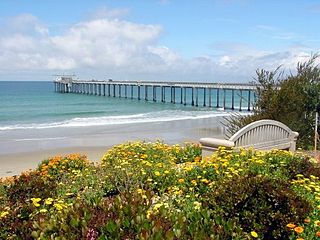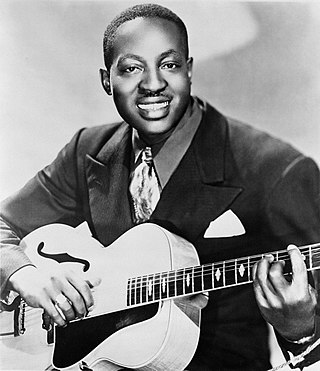Related Research Articles

Scripps Institution of Oceanography (SIO) is the center for oceanography and Earth science at the University of California, San Diego. Its main campus is located in La Jolla, with additional facilities in Point Loma.

Big Bill Broonzy was an American blues singer, songwriter, and guitarist. His career began in the 1920s, when he played country music to mostly African-American audiences. In the 1930s and 1940s, he navigated a change in style to a more urban blues sound popular with working-class black audiences. In the 1950s, a return to his traditional folk-blues roots made him one of the leading figures of the emerging American folk music revival and an international star. His long and varied career marks him as one of the key figures in the development of blues music in the 20th century.
Rosie Nix Adams was an American singer, in the genres of country, folk, and gospel.

Homer and Jethro were the stage names of American country music duo Henry D. "Homer" Haynes (1920–1971) and Kenneth C. "Jethro" Burns (1920–1989), popular from the 1940s through the 1960s on radio and television for their satirical versions of popular songs. Known as the Thinking Man's Hillbillies, they received a Grammy Award in 1959 and are members of the Country Music Hall of Fame.

Gilbert Vandine "Cisco" Houston was an American folk singer and songwriter, who is closely associated with Woody Guthrie due to their extensive history of traveling and recording together.

Kenneth Charles "Jethro" Burns was an American mandolinist and one-half of the comedy duo Homer and Jethro with Henry D. "Homer" Haynes.

"Kisses Sweeter Than Wine" is a popular song, with lyrics written and music adapted in 1950 by Pete Seeger and Lee Hays of the Weavers. It became a US hit in a version recorded by the Weavers in 1951, and an even bigger hit in 1957 when recorded by Jimmie Rodgers. Frankie Vaughan also had a top ten hit with the song in the UK in 1958.
Joel Walker Hedgpeth was a marine biologist, environmentalist and author. He was an expert on the marine arthropods known as sea spiders (Pycnogonida), and on the seashore plant and animal life of southern and northern California; he co-authored Between Pacific Tides, the definitive guide to California intertidal organisms. He was a spokesperson for care for the floral and faunal diversity of the California coastline.
Paul Ackerman was an influential music journalist.

"That Ol' Wind" is a song co-written and recorded by American country music singer Garth Brooks. It was released on September 30, 1996 as the sixth and final single from his album Fresh Horses. The song peaked at number 4 on the U.S. country charts and number 3 on the Canadian country charts. It was written by Brooks and Leigh Reynolds.

"It's Midnight Cinderella" is a song co-written and recorded by American country music singer Garth Brooks. It was released in June 1996 as the fifth single from his album Fresh Horses. The song reached a peak of number 5 on the U.S. country charts in mid-1996. It was written by Brooks, Kent Blazy and Kim Williams.

"Country Boy" is a song written by Tony Colton, Albert Lee, and Ray Smith of the British band Heads Hands & Feet, and recorded by American country music artist Ricky Skaggs. It was released in February 1985 as the second single and title track from the album Country Boy. The song was Skaggs' ninth #1 country hit. The single went to #1 for one week and spent a total of 13 weeks on the country chart.

"I Want to Be Loved Like That" is a song written by Phil Barnhart, Sam Hogin and Bill LaBounty, and recorded by American country music band Shenandoah. It was released in September 1993 as the second single from the album Under the Kudzu. The song spent 20 weeks on the Hot Country Songs charts, reaching a peak of number 3. It also went to number 2 on Gavin Report and number 1 on Radio & Records. The song also peaked at number 4 on the RPM Country Tracks charts dated January 24, 1994.
"Brotherly Love" is a song written by Jimmy Alan Stewart and Tim Nichols, which has been recorded by Moe Bandy, as well as a duet between Keith Whitley and Earl Thomas Conley.

"We Had All the Good Things Going" is a song written by Mervin Shiner and Jerry Monday that was originally recorded by American country artist Jan Howard. Released as a single, it made the top 20 of the US country songs chart in 1969. It later appeared on her 1970 studio album Rock Me Back to Little Rock. The song received reviews from Billboard and Cash Box magazines.

For God and Country is a studio album by American country artist Jan Howard. It was released by Decca Records in January 1970 and consisted of 11 tracks. The project was a collection of 11 tracks dedicated to Howard's son who was killed in the Vietnam War. The songs on the album were both patriotic and inspirational music. It was given a positive review by Billboard magazine.

Rock Me Back to Little Rock is a studio album by American country artist Jan Howard. It was released by Decca Records in June 1970 and was her tenth studio album. The project contained 11 tracks with a mixture of original tunes and cover songs. Among its tracks were two single releases: "We Had All the Good Things Going" and the title track. Both made appearances on the US country songs chart between 1969 and 1970. The album itself also made the US country chart. Both Billboard and Cash Box magazines reviewed the album following its release.

"Each Minute Seems a Million Years" is a country music song written by Alton "Cook" Watson and sung by Eddy Arnold, billed as "Eddy Arnold, The Tennessee Plowboy and His Guitar". It was released in 1945 on the RCA Victor label with "You Must Walk the Line" as the "B" side. In debuted on the Billboard folk chart on June 30, 1945 and peaked at No. 5. It was the first of 128 hit singles for Arnold.
"When We Tried" is a song written by Jerry Chesnut that was originally recorded by American country artist Jan Howard. Released as a single by Decca Records, it made the top 40 on the US country chart in 1969. It was given a positive review by Cash Box magazines and appeared on her eponymous 1969 studio album.
"Rock Me Back to Little Rock" is a song written by Lola Jean Dillon that was originally recorded by American country artist Jan Howard. Released as a single by Decca Records, it reached the top 40 of the US country songs chart in 1970. It was later included on her studio album of the same name. The song received a positive response from Cash Box magazine following its release.
References
- 1 2 "A Little Bit About Leslie Hinton (1917-2005)". Sam Hinton Website. 2002. Retrieved 2018-04-27.
- ↑ McKinley Lawless, Ray, Folksingers and Folksongs in America: A Handbook of Biography, Bibliography, and Discography, (Duell, Sloan and Pearce, 1960), pg. 115
- ↑ Stambler, Irwin Stambler Encyclopedia of Folk, Country and Western Music (Grelun Landon), pg. 134.
- ↑ Stambler, Irwin Stambler Encyclopedia of Folk, Country and Western Music (Grelun Landon), pg. 34.
- 1 2 Stambler, Irwin Stambler Encyclopedia of Folk, Country and Western Music (Grelun Landon), pg. 135.
- ↑ Science, by American Association for the Advancement of Science, (HighWire Press, JSTOR Organization), v. 98 1943, Jul-Dec; pg 383.
- ↑ Elizabeth Noble Shor, Scripps Institution of Oceanography: Probing the Oceans 1936 to 1976. San Diego, Calif: Tofua Press, 1978. pp 186-187.
- ↑ Cohen, Ronald D. Cohen Rainbow Quest: The Folk Music Revival and American Society, 1940-1970 (Univ of Massachusetts Press, 2002), Pg. 85.
- ↑ Sam Hinton recordings at Folkways Archived 2011-10-01 at the Wayback Machine
- ↑ Joel Walker Hedgpeth, Common seashore life of southern California: Illustrated by Sam Hinton. Edited by Vinson Brown (Naturegraph ocean guidebooks) (Pamphlet)
- ↑ San Diego Folk Song Society Archived 2008-07-24 at the Wayback Machine